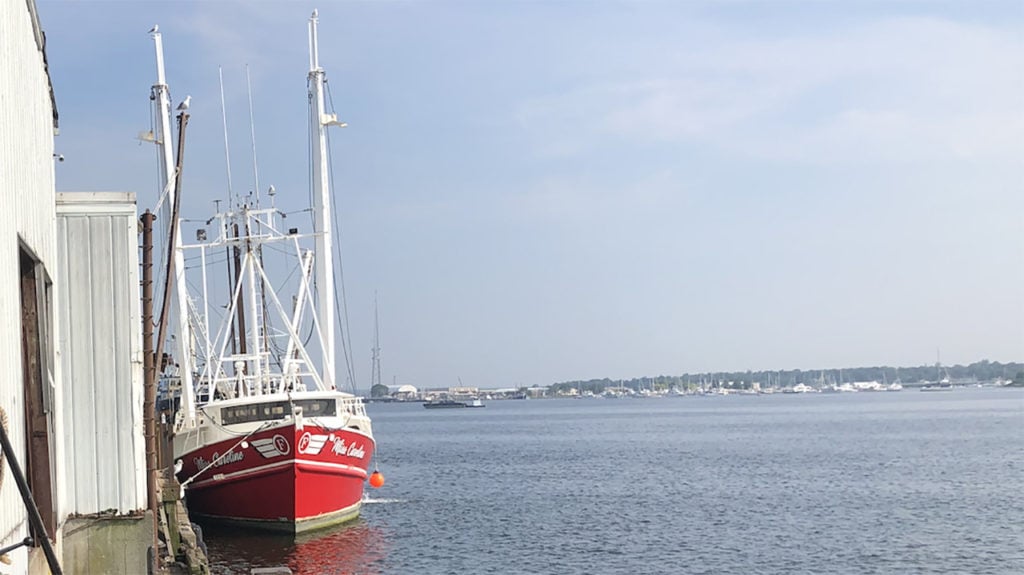Last Updated on December 16, 2020
Even on a quick visit to the coastal Massachusetts city of New Bedford, it’s easy to see how vital the fishing has been to its history, and more importantly, how the industry remains the city’s lifeblood.
Lined with cobblestone streets, sailor-themed bars, and nautical landmarks, it’s easy to find lots of not-so-subtle hints to the days when the whaling industry reigned. While times have changed and whaling is no longer the central economic driver, New Bedford remains the number-one fishing port in America. That’s because it’s the gateway to prized waters abundant with cod, lobsters, yellowtail flounder and, you guessed it, sea scallops.
Sea scallops have a slightly different texture than their bay-based counterparts. Another thing to be aware of is that all scallops tend to have a wide-range of different sizes.

Color Your World
The sea scallops you’ll find in your ButcherBox order are sustainably harvested in the cold waters of Georges Bank, one of the regions New Bedford boats catch scallops. Vessels set out from the port of New Bedford for days-long trips to harvest wild scallops from the smooth- and hard-bottomed Georges Bank.
There’s something special about Georges Bank scallops—something that even the most untrained eye could easily detect. What distinguishes them from other bay and sea scallops is their color. They can be a pearly white color, as you’d expect, but they’re also known to have a muted orange hue.
According to Dr. Kevin Stokesbury of the University of Massachusetts, Dartmouth, “A Georges Bank Scallop often has a natural color variation of white and orange. This orange coloration happens in female scallops during spawn where they produce an excess of natural orange or pink pigment called zeaxanthin which often makes the scallop taste sweeter.”
Auction Day
Once they’re harvested from Georges Bank, the scallops are shucked, rinsed, and stored in mesh bags on ice until they reach New Bedford—ready to begin a new phase of their journey.
In the darkness of early morning, scallopers unload at the Whaling City Seafood Display Auction. The scallops are sorted into large ice vats and labeled with information including the weight of the catch and the name of their vessel.
The auction isn’t what most people might expect. There’s not a fast-talking auctioneer, and there aren’t crowds of people lined up to bid—that’s all done electronically now. Every morning, the auction generates a report outlining the scallops of the day. Buyers can find the list online and review before the bidding starts at 9:00 a.m. sharp.
While the auction report is quite comprehensive, some buyers prefer to check the quality of the scallops firsthand before they make the decision to purchase.
At ButcherBox, we work with a buyer who believes in taking this important extra step. The company we partner with, located just a short walk from the auction in New Bedford, sends quality experts down to scope out the scallops in the morning just before auction time. For us, this small bit of attention to detail makes all the difference.

Check, Check, Check
While the scallops in each large vat of ice might look virtually the same to most people, there are important differences that can only be detected by our experienced quality experts. They look at the color of the scallops to ensure they’re bright white (versus dull gray), or, that distinctive orange hue.
They’ll go around to the vats selected and check the texture of the scallops. It’s something you just have to feel. They can hold a scallop in one hand to tell whether it’s “just right.”
While they’re walking from vat to vat at the auction, they’re not only looking at the scallops themselves. They’re checking the concrete floors. If there’s a large puddle of milky white liquid pooling below a vat, that’s a sign of lower quality, making those scallops a no-go.
Place Your Bids
The quality experts note the lot numbers that pass their checks before heading back to the processing facility. They’ll sit with the owner and the treasurer to go over the list for the day. At 8:55, they get ready for bidding time.
In an almost anticlimactic turn of events, the auction opens. In a few quick, quiet clicks, the scallops have been sold.
Scallops on the Move
After the scallops are purchased at auction, they come to the processing facility right down the street in New Bedford. This is where they scallops are cleaned, frozen, sorted, and placed into the bags you see when you open your ButcherBox delivery—but not without a few more checks for quality along the way.
Each bag is labeled with a QR code that provides comprehensive traceability back to catch location, date, and other information provided through a partnership with Legit Fish.
The details shared by Legit Fish are not quite the same as taking a trip to New Bedford. But it’s almost like being there on the scalloping vessel, harvesting thousands of pounds of scallops in Georges Bank, and then unloading the haul at the auction house. At every step of the way, you can trust that the scallops that arrive at your door are of the highest quality.
Danielle Sirk is the Senior Copywriter at ButcherBox with a background in storytelling and food marketing. She believes in the power of meal prepping, poetry, running, and the great outdoors.


